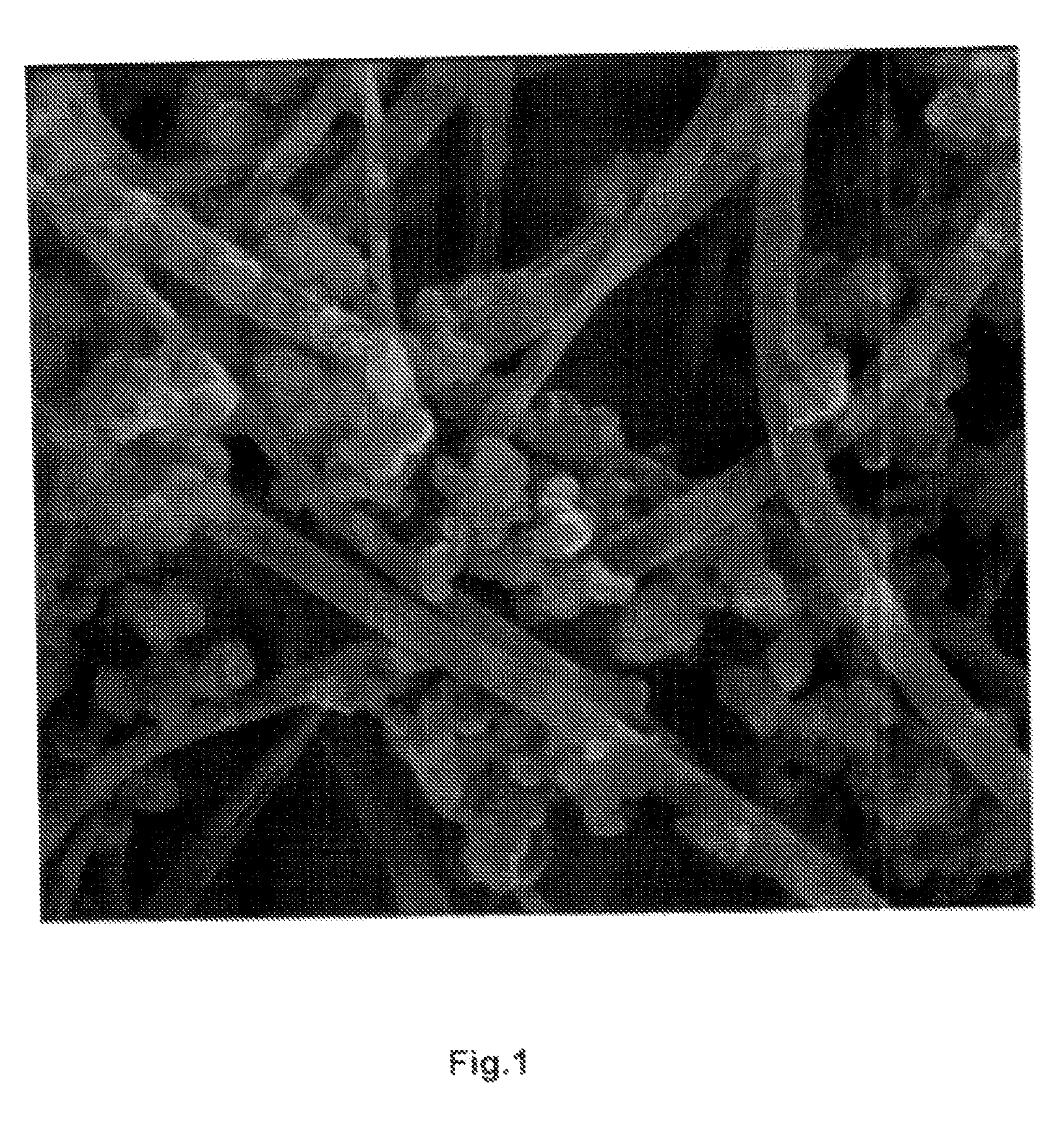Filter material, method for the production thereof, a filter and filtering method
a filter material and filtering technology, applied in the direction of filtration separation, other chemical processes, separation processes, etc., can solve the problems of ineffective water purification, increased product cost, and prolonged contact, and achieve high retention efficiency, low hydrodynamic resistance, and high sorption properties.
- Summary
- Abstract
- Description
- Claims
- Application Information
AI Technical Summary
Benefits of technology
Problems solved by technology
Method used
Image
Examples
example 1
[0060]Suspension is prepared from 180 ml of distilled water, 20 ml of ethyl alcohol and 2 g of Al / AlN powder, produced by the wire electrical explosion method, with specific surface area of 21 m2 / g. A workpiece of 50×50 cm in size is cut out of the nonwoven polysulfone fabric with surface density of 28 g / m2, and then it is put into the container with prepared suspension for 10 min for impregnation at room temperature. Here the powder is absorbed on the fibers of nonwoven fabric and the workpiece dyes black. Then the workpiece is taken out of the container, squeezed and washed for the surplus suspension to be removed. When heating the workpiece up to a temperature of 57° C., the hydrolysis reaction starts, accompanied by evolution of small amount of ammonia and hydrogen and discoloration of the workpiece from black to white due to the Al / AlN conversion into white aluminum hydroxide. With hydrolysis completed, the workpiece is put into the drying box for 4 hours. The material containi...
example 2
[0064]Suspension is prepared from 200 ml of distilled water and 2 g of Al / AlN powder, produced by the wire electrical explosion method, with specific surface area of 21 m2 / g. A workpiece of 50×50 cm in size is cut out of the nonwoven cellulose acetate fabric with surface density of 32 g / m2, and then it is put into the container with prepared suspension for 10 min for impregnation at room temperature. Then the workpiece is taken out of the container and washed with distilled water for the non-fixed particles of aluminum hydroxide to be removed. Hydrolysis and drying are carried out similarly to Example 1. As a result, the material containing 35 mass.% of aluminum hydroxide with mean particle size of 0.9 μm, with specific surface area of 185 m2 / g and porosity of 85% is produced. The filter is formed by folding 14 layers of filter material similarly to Example 1 and then it is tested for virus absorption. The results are given in Tab. 2.
TABLE 2Concentration of MS2 in the original suspe...
example 3
[0067]Suspension is prepared from 200 ml of distilled water and 2 g of aluminum powder, produced by the wire electrical explosion method, with specific surface area of 15 m2 / g and average particle size of 150 nm. A workpiece of 50×50 cm in size is cut out of the nonwoven cellulose acetate fabric with surface density of 32 g / m2, and then it is put into the container with prepared suspension for 10 min for impregnation at room temperature. Here the workpiece dyes black due to the aluminum particles absorption on the fibers of the material. Then the workpiece is taken out of the container, squeezed for the surplus suspension to be removed and put into the container with water heated up to 60° C. for the hydrolysis of absorbed aluminum powder Hydrolysis starts with the extraction of gas bubble (hydrogen) from the surface of the workpiece and discoloration of the workpiece from black to white. With hydrolysis completed approximately in 20 min when the workpiece is taken out of the contai...
PUM
| Property | Measurement | Unit |
|---|---|---|
| Temperature | aaaaa | aaaaa |
| Temperature | aaaaa | aaaaa |
| Length | aaaaa | aaaaa |
Abstract
Description
Claims
Application Information
 Login to View More
Login to View More - R&D
- Intellectual Property
- Life Sciences
- Materials
- Tech Scout
- Unparalleled Data Quality
- Higher Quality Content
- 60% Fewer Hallucinations
Browse by: Latest US Patents, China's latest patents, Technical Efficacy Thesaurus, Application Domain, Technology Topic, Popular Technical Reports.
© 2025 PatSnap. All rights reserved.Legal|Privacy policy|Modern Slavery Act Transparency Statement|Sitemap|About US| Contact US: help@patsnap.com

